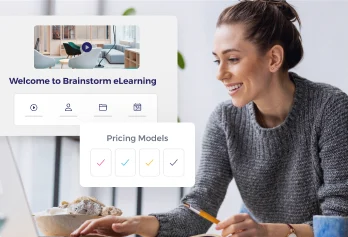In episode 1 of season 2 of the Return on Intelligence podcast, Rich Fernandez chatted with Bill Duane, an advisor to Google X and Amazon, about the importance of care and compassion in AI systems, the future of work, and the critical skills teams need to navigate complexity and ambiguity. Their conversation explores different approaches to skills building and learning and development (L&D) in the context of managing stress and anxiety, as well as the importance of problem-oriented approaches, community-based learning, and integrating well-being with business results.
We’ve taken some of the key takeaways from their discussion. If you want to get a better understanding on each of the topics the full episode is below for you to watch or listen.
1. Care and compassion are essential in building human-centric AI systems.
No matter the technological advances we’re seeing, expertise and experience can’t be underestimated, with empathy, emotional intelligence, and nuance remaining uniquely human skills. As we see more technological advancement, our ability to have and nurture emotional intelligence is the key to building resilience and remaining relevant.
More than ever, people strategy is business strategy. L&D teams are already the advocates for learners; now is the time to become the champions of AI as well. There’s an opportunity to deliver value at the intersection of people and AI to help people perform better at their jobs. Start conversations around the ethics of AI in the workplace, and how L&D teams can add guardrails that monitor and mitigate biases. AI isn’t a replacement for authentic human-led learning; it should be used as a building block to complement your expertise.
Reassess learning challenges with AI. Understand the problems you’re solving for to avoid the trap of using AI to scale what hasn’t worked before.
2. Community-based learning and peer-to-peer support are essential for deep integration of skills and knowledge.
Community-based learning and peer-to-peer support facilitate real-world application, collaboration, and ongoing development. When learners, both internal and external, engage in community-based learning, they have the opportunity to share experiences, expertise, and insights with their peers, helping to build a culture of continuous learning and innovation.
It’s a way of gaining hands-on experience and practical advice from those who have directly applied the skills or knowledge in similar contexts, leading to a deeper understanding of concepts and their application.
This type of approach to learning creates a more agile and adaptable workforce. Learners become better equipped to address complex challenges and leverage diverse perspectives to problem-solve effectively, improving overall decision-making, increasing creativity, and enhancing team cohesion. Leading to greater efficiency, innovation, and competitive advantage. Who wouldn’t want that?
3. The future of work will require skills in navigating complexity and ambiguity.
While we’re all tired of reading ‘In these unprecedented times…’, ‘In the ever-evolving digital landscape…’ and ‘Due to the complex nature of the modern work environment’, the statements aren’t wrong. Everyone benefits from having the ability to adapt to change, and to maintain a positive outlook amidst challenges and unexpected disruptions. Making skills like resilience, being comfortable with ambiguity, and cognitive flexibility are critical in the future of work.
According to LinkedIn, some of the most in-demand, emerging skills in 2024 are problem-solving and research. Providing learners with courses that focus on building these skills would benefit a company as a business evolves.
The value of upskilling and reskilling. Examine ways L&D teams can use upskilling and reskilling to ensure their teams remain relevant and competitive.
4. Integrating well-being practices into the workplace not only improves individual well-being but also accelerates business results.
Integrating well-being practices like flexible work arrangements, mental health support, physical well-being programs and social initiatives that promote inclusivity and belonging in the workplace can help enhance employee satisfaction, engagement, and productivity. All key areas that organizations want to improve.
When there’s a positive work environment, employees feel supported, there’s a sense of belonging and they’re better equipped to perform at their best. The longer your workforce stays with you, the more you save on recruitment and training costs, and maintaining institutional knowledge within your organization.
Well-being practices can also lead to a more innovative and creative workforce, as employees are better able to focus, think critically, and generate new ideas. This contributes to increased productivity and efficiency, directly impacting the bottom line. This creates a positive cycle of improved individual well-being and accelerated business results.
5. L&D leaders should take a problem-oriented approach to skills building, focusing on solving specific business problems.
Aligning learning with real-world challenges, results in practical, relevant, and impactful skill development. Applying skills to problems today makes learning purpose-driven and meaningful, demonstrating the practical application of newly acquired skills to solve actual workplace challenges. There are tangible, practical things organizations can do right now to start on their journey to realizing value without waiting to build their skills engine for future skills gaps and long-term transformation.
- Are there any underperforming operations today that need addressing?
- What are the current skills gaps?
Once you move away from being reactive, then you build the processes for proactive and predictive skills development.
Benefits to learners include increased motivation and engagement, as they’re intrinsically motivated to acquire skills that will enable them to progress in their career. For the business, a problem-oriented approach to skills building results in a workforce that is better equipped to address current and future challenges. Employees become more agile, adaptable, and skilled at identifying and resolving issues, leading to improved operational efficiency, decision-making, and innovation.
Closing the skills gaps with custom learning paths. Create a learner-driven, adaptive learning environment with AI-powered learning paths to develop all your learners and growth.

Want more great content like this? Season 2 of the Return on Intelligence podcast, hosted by Rich Fernandez CEO of SIY Global, tackles solutions for L&D team challenges, while exploring strategies to equip you and your learners for the future of work through emotional and artificial intelligence. From facilitating learning in the workplace to mastering consumer training best practices, each episode has valuable tips and strategies. Catch up on all episodes by subscribing!





